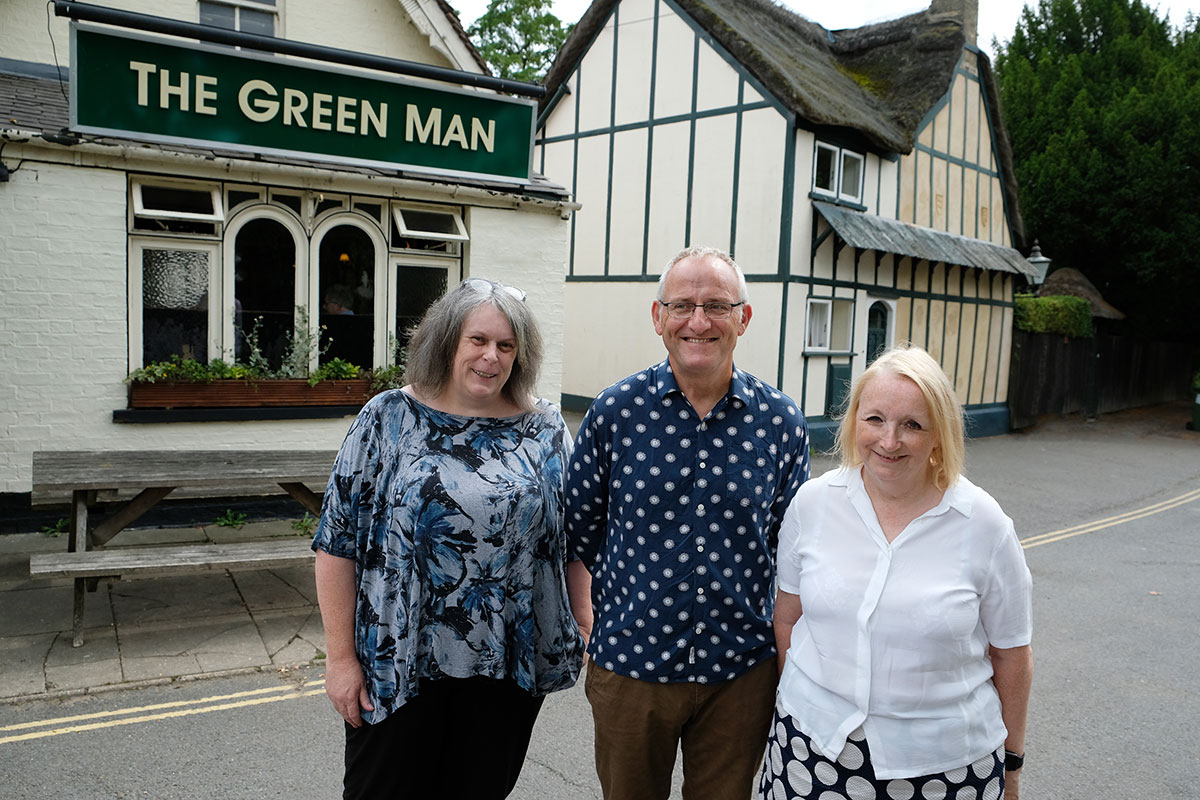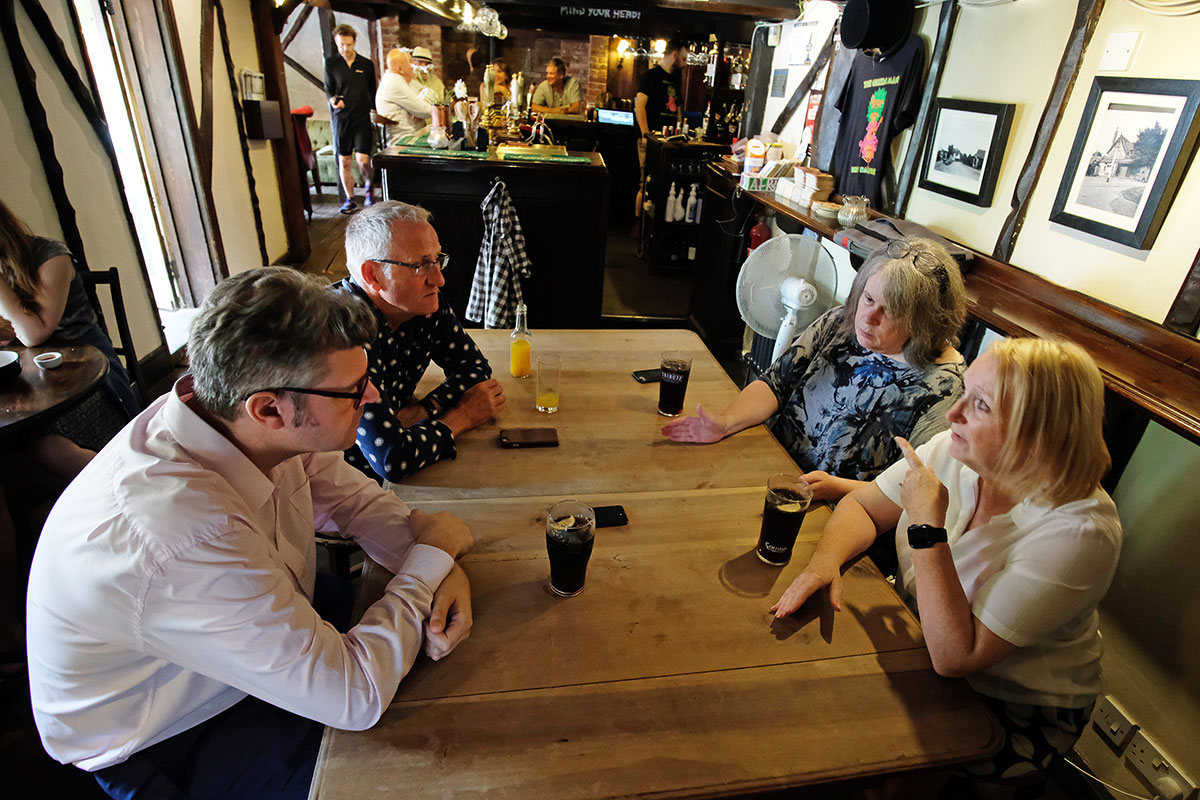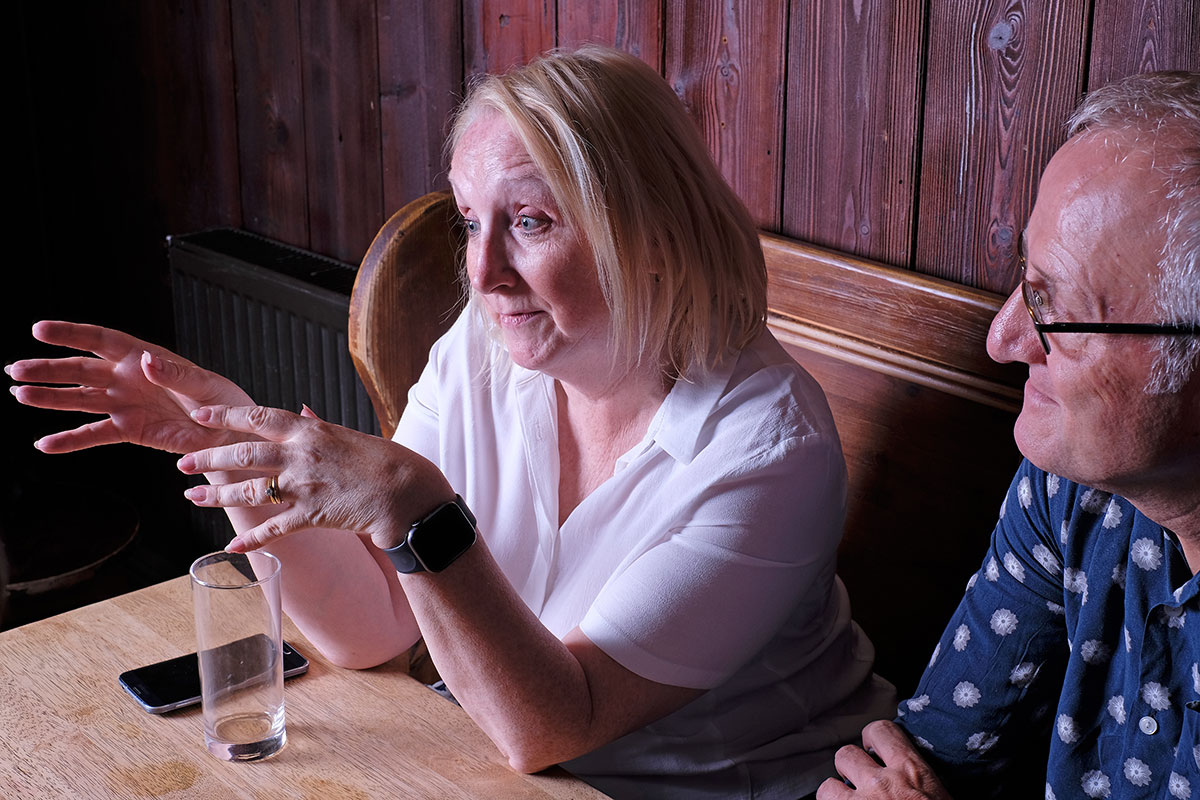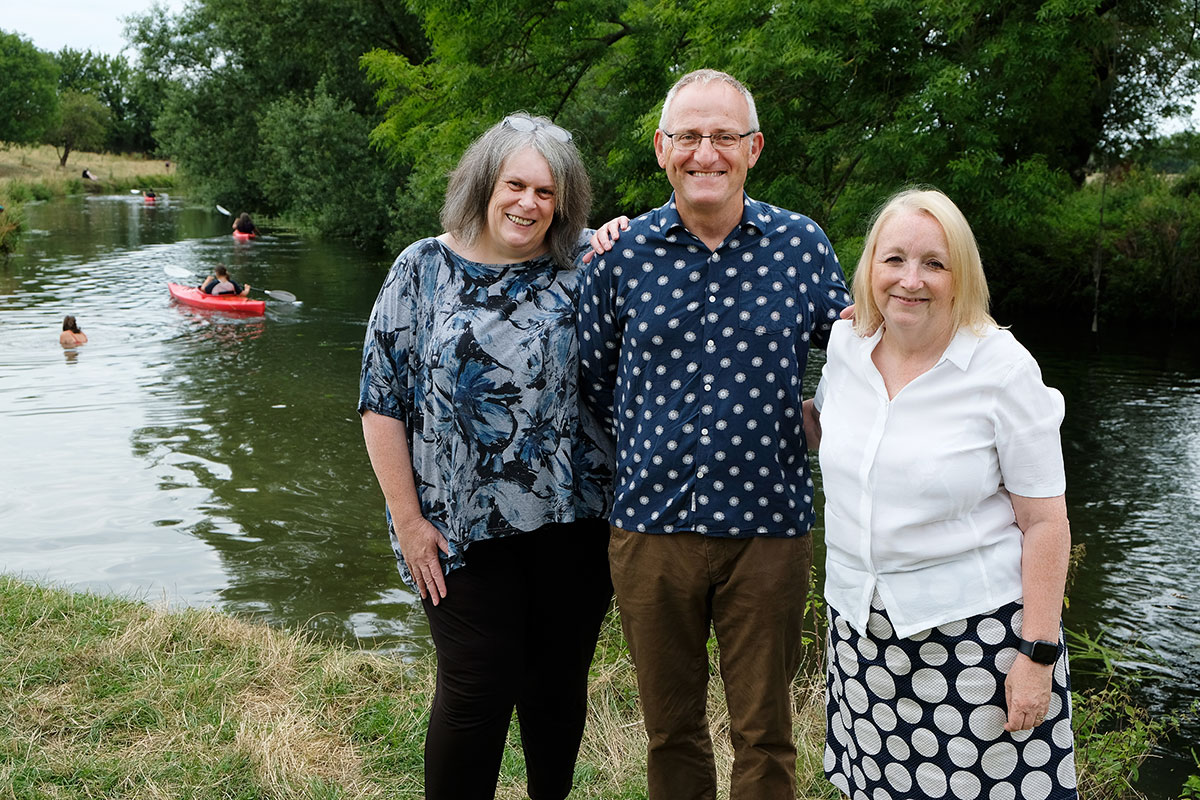You are viewing 1 of your 1 free articles
The battle to save social rent
Half a decade ago, social rent was on its last legs and shadow housing minister John Healey accused landlords of barely putting up a fight to save it. Then, a small band of housing professionals and tenants decided to step up to the plate.
Martin Hilditch looks at how the battle to save social rent has gone mainstream. Photography by John Robertson
Above (left to right): Alison Inman, Colin Wiles and Aileen Evans outside the Green Man pub in Grantchester, Cambridge, where their plan to save social rented housing took root
Back in 2014, four housing professionals on a mission met up in the picturesque village of Grantchester, near Cambridge.
The members of the group barely knew one another. But they had been drawn together by a single fear – that the death knell had been sounded for social rented housing.
They weren’t wrong.
As they squeezed around a tiny table in the Green Man pub to discuss the problem, social housing was facing an existential threat.
David Cameron’s government had cut all grant funding for the tenure, making it almost impossible to build new socially rented homes in significant numbers. Increased Right to Buy discounts meant that existing council homes were flying out the door at a far faster rate than they could be replaced. And social landlords were being pressured to convert empty homes to the government’s new ‘affordable rent’ product, which was much more expensive than social rents in many areas of the country, in order to obtain grant.
In 2010, Inside Housing had announced on its front page that it thought the impact of some of the government’s plans would mark “the end of social housing”.
By 2014 it was being proved right.
The members of the group knew what this would mean for people on low incomes. They predicted that the slow demise of social housing would increase homelessness and trap more and more people in the insecure and more expensive private rented sector.
It was an article in The Guardian in 2013 that galvanised the four to act.
In it, shadow housing minister John Healey criticised the housing sector for being “reluctant to pick a fight with the government” (in a bid to forge a relationship with Whitehall in the face of relentless hostility) and said some providers were beginning to “stretch their social purpose”.
After discussing the article on Twitter the quartet realised he was right and decided that enough was enough.
They met up and within a couple of hours the Social Housing Under Threat (SHOUT) campaign was born. Social rent’s fightback was underway.
Today, five-and-a-half years and two prime ministers later, Inside Housing has reunited the original team back at the venue where it all began.
We wanted to find out how calls for more social rented housing went from being very much a minority sport to one that is now mainstream, with Shelter, the National Housing Federation (NHF) and even former prime minister Theresa May calling for many more social homes to be funded.
What part do the founder members of SHOUT think it played in bringing social housing back from the brink and how can their learning inform future campaigns? And, with new prime minister Boris Johnson apparently focused on homeownership as the gears of his election machinery start to whir, do they think social rent is about to find itself back at square one?
Inside Housing sits down with three of the founding members of SHOUT at the same table where that first meeting took place to assess how far they’ve come.
Present are Aileen Evans, now chief executive of Grand Union Housing Group and who later this year will take up the presidency of the Chartered Institute of Housing (CIH), former CIH president Alison Inman and housing and planning consultant Colin Wiles.
One of the original four, Tom Murtha, the blogger and former chief executive of Midland Heart housing association, is unable to make the reunion.
Ms Inman recalls how SHOUT was born out of a disappointment that various housing institutions, such as the NHF, appeared to have “given up on social rent”.
“People had given up on there ever being that investment again and it was all about, ‘We have got to make affordable rent work,’ and that level of grant had gone forever,” she says.
Mr Wiles says it felt like affordable rent was in danger of “becoming the only game in town”.
The three housing professionals discuss why they formed SHOUT and what has happened since with Inside Housing editor Martin Hilditch
“It [affordable rent] felt to me a bit like the Emperor’s New Clothes,” Ms Evans adds.
“How do you cut the housing benefit bill, provide good-quality, properly affordable housing for people and yet reduce grant and make rents more expensive? I remember being mystified by this and mystified as to why other people weren’t saying, ‘Hang on a minute, this is an equation that doesn’t work.’”
Apart from agreeing that they wanted to go into bat for social rent, the founder members also agreed that they wanted to address the way that they felt social tenants were being stigmatised by government and the media, particularly through programmes such as Channel 4’s notorious Benefits Street.
The group felt the othering of tenants was reducing the chances of future generations being able to access social housing at all.
“If the public narrative is that people in social housing are somehow different to everybody else, it makes it hard [to get government to invest],” Ms Inman explains.
With everyone agreed on the issues that needed addressing, it was also apparent that four individuals wouldn’t be able to change things on their own.
More people who shared similar views, some of whom had already been in touch on social media, would need to join up.
“It [affordable rent] felt to me a bit like the Emperor’s New Clothes”
Aileen Evans, chief executive, Grand Union Housing Group
Newly christened as SHOUT, the group began recruiting members who could help and Mr Wiles drew up a manifesto, setting out SHOUT’s aims. Behind the scenes, individuals such as tenant (and future Shelter housing commissioner) Rob Gershon, tenant advisor Tim Morton, former programme director at the Local Government Association (LGA) Martin Wheatley, housing blogger Steve Hilditch (the author declares a connection), Lucy Ferman, project manager with the Placeshapers group of housing associations, Tony Stacey, then-chair of Placeshapers, and Kate Murray, former Inside Housing editor, got involved in the campaign, too.
“We touched a nerve really and people piled in,” Mr Wiles states.
Despite having been inspired by shadow housing minister John Healey’s comment piece, the group were also clear that they could only gain traction if this was a cross-party campaign.
By June 2014, the manifesto was ready. It called for 100,000 new social rented homes to be built every year and for restrictions on council borrowing to be lifted to enable them to build more homes.
Crucially, the launch was indeed a cross-party affair, with speeches from Mr Healey, along with the Conservative vice-chair of the LGA Gary Porter, Liberal Democrat MP John Leech and then-Green Party leader Natalie Bennett. By working to build consensus behind the scenes, the group ensured that their ideas had if not buy-in, then at least credibility in varying corners of the political spectrum.
“To have any kind of credibility it had to be seen as a cross-party thing,” Mr Wiles declares.
“We were looking at the traditions of (former Conservative prime minister) Harold Macmillan building 300,000 council houses. The Tories at one time were just as much pro-council housing as Labour.”
At the launch, Mr Murtha issued a passionate call to arms, stating that: “For some years we have witnessed the slow death of social housing and done nothing.
Aileen Evans is now chief executive of Grand Union Housing Group
“We as a housing sector have fallen asleep on our watch and in our stewardship of social housing.”
Not everyone was convinced by SHOUT’s rhetoric and its approach, however. The group say NHF chief executive David Orr was sceptical at the launch, and in an interview with Inside Housing in 2015, he stated: “I think we need to be arguing for the product, not the label, and I do sometimes wonder [for SHOUT] if the label gets in the way.”
He went on to say that his “instincts are always to battle in private”.
“I think we were seen [by some] as being incredibly naïve,” Ms Inman reflects.
“It’s easier to dismiss you if you say, ‘Oh, they’re living in the past.’ We felt that social housing, in the words of Peter Kay, is the future, just like garlic bread. But actually, it is the only way we can solve the problems that we have got now. It is not about a golden age.”
Rule number one of campaigning is not to be deterred by naysayers. Nevertheless, the group did want to beef up the credibility of their arguments that social rented housing would help solve some wider societal issues.
For this reason, following a suggestion by Martin Wheatley, they commissioned – along with the National Federation of ALMOs – economics advisors Capital Economics to look at the potential fiscal benefits of social rent.
“To have any kind of credibility it had to be seen as a cross-party thing”
Colin Wiles, planning consultant
That report concluded that unless more homes at social rent are built the housing benefit bill would soar in the coming years – and that eight out of 10 households receiving benefit in the private rented sector would be better off in social rented housing.
It suggested that the economic case for investing in social rented housing “is unanswerable”.
“I think we had a nod to the past in the cross-party nature of council housing, but actually I think we were about campaigning for the future,” Ms Evans states.
“We were trying to paint a picture of a brighter future and economically what it would mean for people. So that was the piece of work that followed on from the launch really.”
A year after their launch, members of SHOUT stood outside the NHF’s Homes for Britain rally, lobbying attendees about investment in social housing.
People were talking about the group and social rented housing again – although the actual core team remained quite small. The founder members think its vocal public approach had a wide impact.
“We gave people permission, I think, to talk about social housing again and to ask for social housing,” Ms Inman states.
“I think that has been our big success,” Ms Evans adds.
“The economic arguments notwithstanding, I think the fact that we were saying, ‘Hey, come on, we need to be building social housing,’ made it alright for other people to say it.”
There were other voices beginning to tell a different story about social housing at this time, too. The high-profile Municipal Dreams blog by John Boughton which began in 2013 looked at some of council housing’s success stories. A campaign to tackle stigma, Benefit to Society – now known as See the Person – was also set up by a group of housing associations and is now run by tenants.
Under new chief executive Polly Neate, Shelter set up a commission to look at social housing (which Mr Gershon was part of). It concluded that government should fund 3.1 million social homes over the next 20 years.
By 2018, under the more benign environment of Theresa May’s government, the NHF was calling for 90,000 social rented homes to be built a year. The Chartered Institute of Housing has called consistently for more social rent under its chief executive Terrie Alafat, too.
For Ms Evans, all this goes to show that a campaign that many thought was pointless can bring about change.
“I think they thought the arguments were unwinnable, so why have them?” she says of the people who criticised SHOUT from the outset.
“I think actually Polly Neate since she has been at Shelter has proved that that is not the game we should be playing,” she adds – suggesting the important thing is to work out what needs to be done and campaign and build consensus around getting there.
But while Theresa May was singing the praises of social housing by the end of her tenure, we are now operating in a different world. Boris Johnson has barely mentioned social housing since taking over as prime minister and was critical of the sector in a speech to the Conservative Party conference last year.
Do SHOUT’s founder members anticipate a step back? And do the group ever feel a bit like their clothes have been stolen by other campaigners?
“I take the view that I’m just glad people are talking about social rent,” Ms Evans states. “And if they weren’t talking about it five years ago, we can’t undo that.”
“We gave people permission to talk about social housing again and to ask for social housing”
Alison Inman, former president, Chartered Institute of Housing
Ms Evans also thinks that there is little chance of politicians downplaying the need to build new social housing, because the housing crisis now has such public visibility.
“I think there is a much bigger awareness now of the impact of the housing crisis on people’s families,” Ms Evans assesses.
“The growth in street homelessness and actually what MPs see in their postbags, shared ownership isn’t the solution for it.”
She adds that calls among many Conservative MPs for more social housing under Theresa May’s administration also demonstrate that there are “now advocates [in all parties] that social housing is the solution to the problem that MPs see an awful lot of in their surgeries”.
Either way, the learning to date from taking part in SHOUT means that these campaigners can mobilise quickly again if needed.
“I think what I learned from SHOUT was what my son would call JFDI,” Ms Inman states. “That’s: Just Fucking Do It.”
With a bit of luck, that will be the attitude the new government adopts to social rent. If not, the group sitting round the table today is ready to wade into battle once more.
















